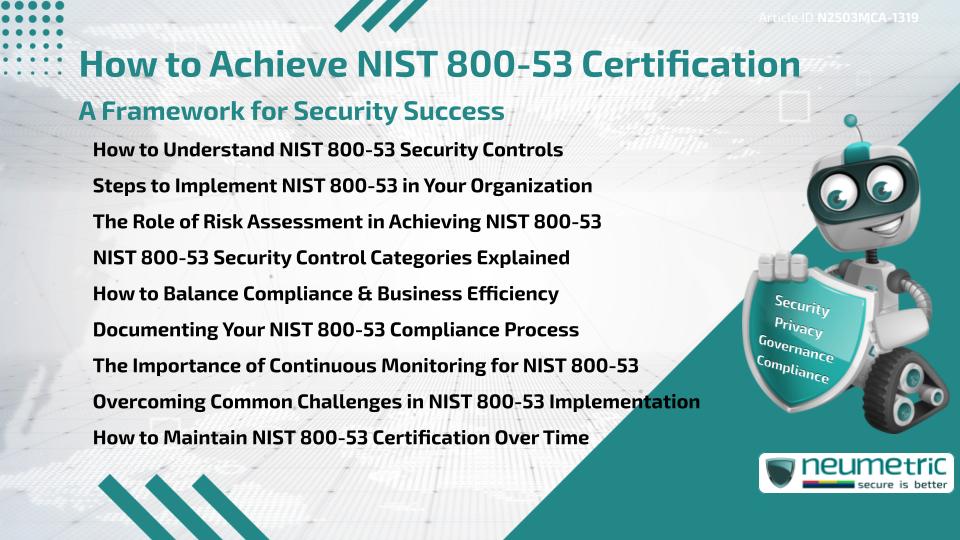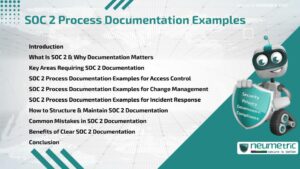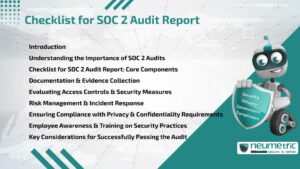Table of Contents
ToggleIntroduction
In today’s rapidly evolving digital landscape, achieving robust cybersecurity practices is more important than ever. One of the most trusted frameworks for ensuring cybersecurity in organizations is the NIST 800-53. This set of guidelines is designed to help businesses build & maintain secure information systems. Whether you’re a government agency, a private enterprise or a contractor, understanding how to achieve NIST 800-53 certification can help you meet security requirements & protect Sensitive Data from cyber threats.
In this article, we will break down the key steps & considerations for achieving NIST 800-53 certification. We will also explore the historical context of the framework, practical insights on implementation, & how businesses can balance compliance with real-world challenges.
What is NIST 800-53?
NIST 800-53 is a comprehensive set of security controls designed to help organizations safeguard their information systems. Published by the National Institute of Standards & Technology [NIST], this framework outlines a range of security measures, including risk assessments, access control, incident response, & continuous monitoring. It is primarily aimed at federal agencies, but it is also widely used by private sector organizations looking to improve their security posture.
The goal of NIST 800-53 is to ensure that organizations apply adequate security measures to protect their information systems & manage potential risks effectively. The framework is constantly updated to keep up with new security threats & technological advancements.
The Historical Context of NIST 800-53
NIST 800-53 has evolved from a need to create a standardized approach to cybersecurity for U.S. government agencies. The development of the framework began in the early 2000s when NIST sought to improve federal cybersecurity practices. Over time, it expanded beyond federal use to become a global standard, influencing the cybersecurity strategies of organizations worldwide.
In the beginning, NIST 800-53 was seen as a guideline for federal agencies, but as cybersecurity threats grew more sophisticated, private sector companies also started adopting the framework. Today, NIST 800-53 is widely recognized for its ability to strengthen an organization’s cybersecurity defense mechanisms.
Key Steps to Achieve NIST 800-53 Certification
1. Understand the Framework & Requirements
The first step in achieving NIST 800-53 certification is to thoroughly understand the framework & its requirements. This involves familiarizing yourself with the NIST 800-53 security controls, which cover areas such as access control, incident response, system monitoring, & more. Understanding the framework’s requirements is crucial for knowing what changes need to be made to your organization’s information security policies.
2. Conduct a Risk Assessment
Before you begin implementing the security controls outlined in NIST 800-53, it’s important to conduct a thorough risk assessment. This will help you identify the specific threats & vulnerabilities your organization faces. A risk assessment should evaluate the security of both your physical infrastructure & digital systems.
By understanding where your organization’s risks lie, you can focus your efforts on the most critical areas, ensuring that your NIST 800-53 implementation will be as effective as possible.
3. Implement Security Controls
Once you have a clear understanding of the risks & requirements, the next step is to implement the appropriate security controls. NIST 800-53 provides a catalog of security controls categorized by functionality, such as Access Control [AC], Incident Response [IR], & System & Communications Protection [SC].
You’ll need to choose & apply the relevant controls for your organization’s needs. This might involve updating software, revising security policies or implementing new monitoring systems.
4. Document Everything
NIST 800-53 certification requires thorough documentation of your security policies & procedures. This includes not only the controls you have implemented but also how they are functioning. For each security control, you will need to document the approach, the tools or systems used, & the effectiveness of the control.
This documentation is essential not only for passing the certification audit but also for ongoing security management.
5. Continuous Monitoring & Improvement
NIST 800-53 is not a one-time checklist. It requires continuous monitoring & improvement to stay effective. Regularly reviewing your security measures, conducting periodic risk assessments, & keeping up with updates to the framework will help ensure your security posture remains strong.
A key part of this process is ensuring that any incidents are properly documented & addressed. A well-defined incident response plan is critical for minimizing damage from any cybersecurity threats.
Common Challenges & Considerations
While NIST 800-53 provides a robust framework for cybersecurity, achieving certification can be challenging for many organizations. One common issue is the complexity of implementing all of the required security controls, especially for smaller companies with limited resources.
Another challenge is the need for ongoing commitment to monitoring & improving security measures. Achieving certification is just the beginning; maintaining it over time requires a culture of continuous improvement & proactive risk management.
Lastly, businesses must also balance compliance with operational needs. Some security measures, while effective, may create friction with day-to-day business activities. Finding the right balance between compliance & efficiency can be a delicate task.
Conclusion
Achieving NIST 800-53 certification is a significant milestone for organizations committed to improving their cybersecurity practices. By following the necessary steps, from understanding the framework to continuous monitoring, businesses can build a strong security foundation & better protect their information systems.
While the process can be complex & resource-intensive, the benefits of NIST 800-53 certification—such as improved risk management, enhanced trust with clients, & increased security resilience—far outweigh the challenges.
Takeaways
- NIST 800-53 provides a comprehensive framework for improving cybersecurity practices.
- Achieving certification requires a deep understanding of the framework, conducting risk assessments, & implementing the necessary controls.
- Continuous monitoring & documentation are key to maintaining compliance.
- Organizations must balance compliance with operational efficiency.
FAQ
What is NIST 800-53?
NIST 800-53 is a set of security controls designed to help organizations secure their information systems & manage risks. It is widely used by federal agencies & private sector companies.
Why is NIST 800-53 important?
NIST 800-53 provides a structured approach to cybersecurity, helping organizations protect Sensitive Data, prevent breaches, & maintain a strong security posture.
How long does it take to achieve NIST 800-53 certification?
The time it takes to achieve NIST 800-53 certification depends on your organization’s size, complexity, & the resources available. It can range from several months to over a year.
Can small businesses achieve NIST 800-53 certification?
Yes, small businesses can achieve NIST 800-53 certification, although they may face challenges due to limited resources. Adapting the framework to fit your business’s size & needs is key to success.





